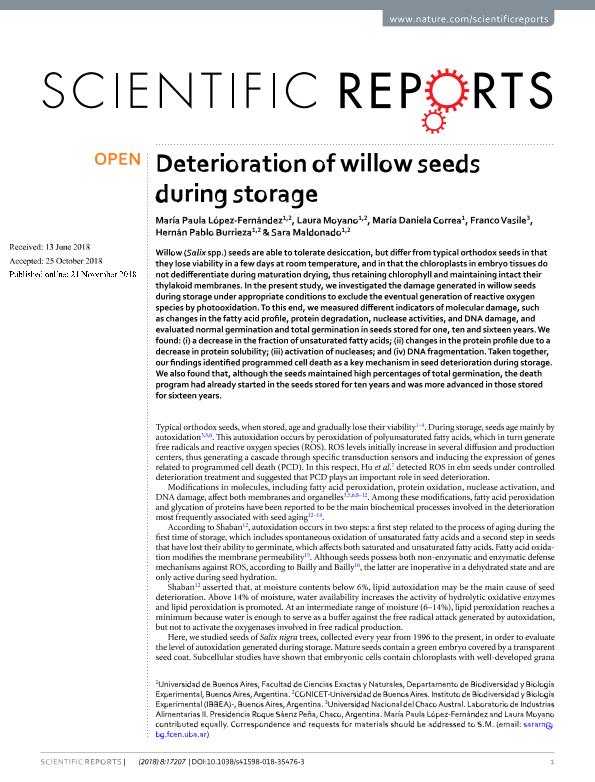Artículo
Deterioration of willow seeds during storage
Lopez Fernandez, Maria Paula ; Moyano, Laura
; Moyano, Laura ; Correa, María Daniela; Vasile, Franco Emanuel
; Correa, María Daniela; Vasile, Franco Emanuel ; Burrieza, Hernán Pablo
; Burrieza, Hernán Pablo ; Maldonado, Sara Beatriz
; Maldonado, Sara Beatriz
 ; Moyano, Laura
; Moyano, Laura ; Correa, María Daniela; Vasile, Franco Emanuel
; Correa, María Daniela; Vasile, Franco Emanuel ; Burrieza, Hernán Pablo
; Burrieza, Hernán Pablo ; Maldonado, Sara Beatriz
; Maldonado, Sara Beatriz
Fecha de publicación:
12/2018
Editorial:
Nature Publishing Group
Revista:
Scientific Reports
ISSN:
2045-2322
Idioma:
Inglés
Tipo de recurso:
Artículo publicado
Clasificación temática:
Resumen
Willow (Salix spp.) seeds are able to tolerate desiccation, but differ from typical orthodox seeds in that they lose viability in a few days at room temperature, and in that the chloroplasts in embryo tissues do not dedifferentiate during maturation drying, thus retaining chlorophyll and maintaining intact their thylakoid membranes. In the present study, we investigated the damage generated in willow seeds during storage under appropriate conditions to exclude the eventual generation of reactive oxygen species by photooxidation. To this end, we measured different indicators of molecular damage, such as changes in the fatty acid profile, protein degradation, nuclease activities, and DNA damage, and evaluated normal germination and total germination in seeds stored for one, ten and sixteen years. We found: (i) a decrease in the fraction of unsaturated fatty acids; (ii) changes in the protein profile due to a decrease in protein solubility; (iii) activation of nucleases; and (iv) DNA fragmentation. Taken together, our findings identified programmed cell death as a key mechanism in seed deterioration during storage. We also found that, although the seeds maintained high percentages of total germination, the death program had already started in the seeds stored for ten years and was more advanced in those stored for sixteen years.
Palabras clave:
Willow Seeds
,
Storage
,
Orthodox Seeds
,
Programmed Cell Death
Archivos asociados
Licencia
Identificadores
Colecciones
Articulos(CCT - NORDESTE)
Articulos de CTRO.CIENTIFICO TECNOL.CONICET - NORDESTE
Articulos de CTRO.CIENTIFICO TECNOL.CONICET - NORDESTE
Articulos(IBBEA)
Articulos de INSTITUTO DE BIODIVERSIDAD Y BIOLOGIA EXPERIMENTAL Y APLICADA
Articulos de INSTITUTO DE BIODIVERSIDAD Y BIOLOGIA EXPERIMENTAL Y APLICADA
Articulos(OCA CIUDAD UNIVERSITARIA)
Articulos de OFICINA DE COORDINACION ADMINISTRATIVA CIUDAD UNIVERSITARIA
Articulos de OFICINA DE COORDINACION ADMINISTRATIVA CIUDAD UNIVERSITARIA
Citación
Lopez Fernandez, Maria Paula; Moyano, Laura; Correa, María Daniela; Vasile, Franco Emanuel; Burrieza, Hernán Pablo; et al.; Deterioration of willow seeds during storage; Nature Publishing Group; Scientific Reports; 8; 1; 12-2018; 1-11
Compartir
Altmétricas



